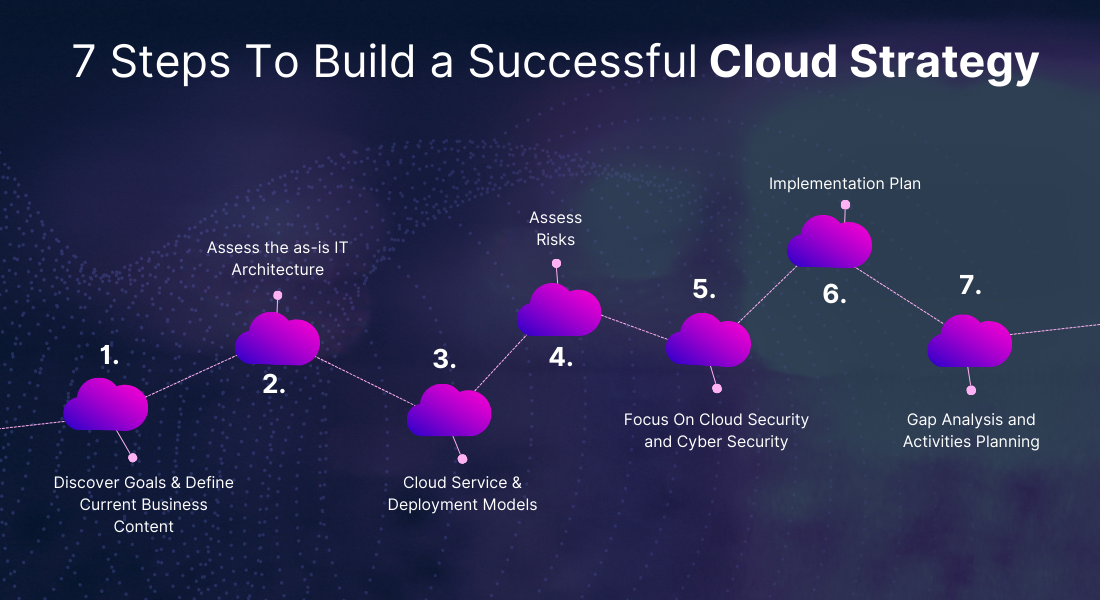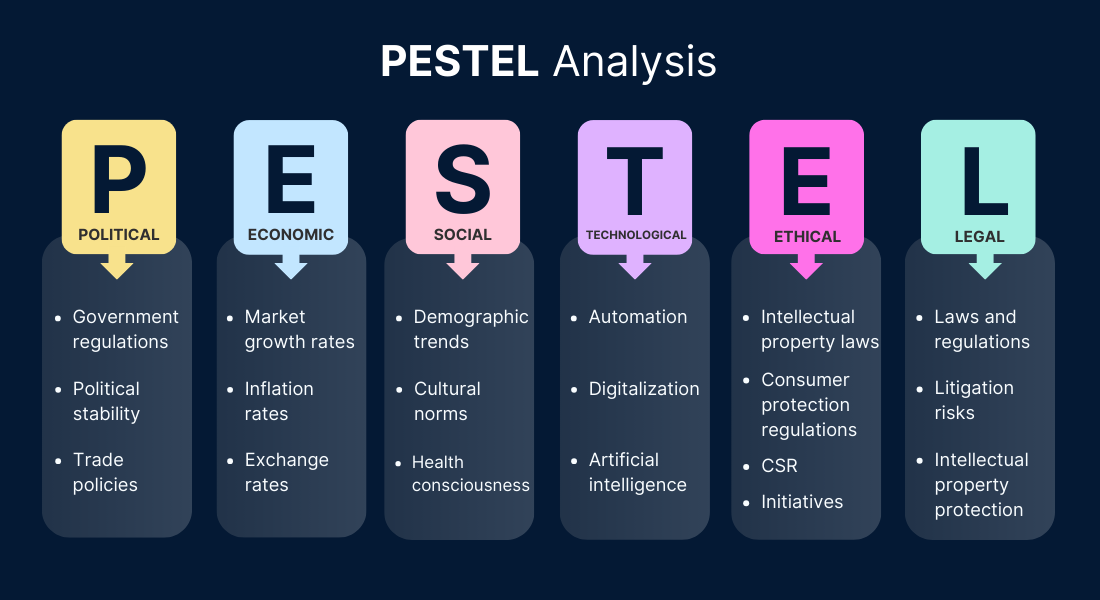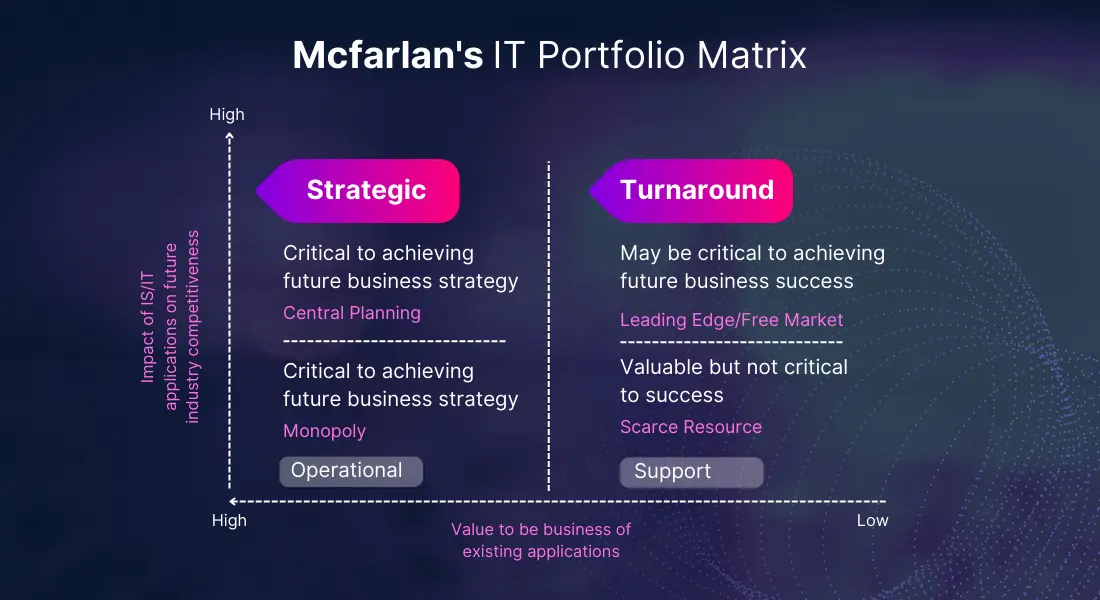An Entrepreneur’s Guide To Build a Winning Cloud Strategy in 2025
Last Updated on February 14, 2025
Quick Summary
This blog provides crucial insights on Cloud Strategy, crafted explicitly for CTOs and CIOs in startup and traditional business sectors. Aimed at those contemplating strategic decisions, it covers various strategy paradigms, their benefits, and practical solutions to address potential challenges. It highlights the need for a well-thought-out Cloud Computing Strategy in today’s business environment.
A well-defined cloud strategy is no longer optional—it’s a must for businesses of all sizes to drive innovation, flexibility, and growth. Statistics reveal that 94% of enterprises seamlessly use cloud services, emphasizing the need for a robust plan. Thus, before adopting any new technological approach, it is crucial to concentrate on what you need and why you need it. This ensures that your tech choices match with your overall business goals. Also, a well-thought-out computing strategy becomes essential to avoid getting swept up in distractions and ensures your focus and resources are used effectively.
Thus, whether you’re an enterprise owner, CTO, or just beginning your cloud journey, this blog equips you with the knowledge to craft a successful cloud computing strategy.
“A cloud strategy is a carefully devised plan that outlines how a company will utilize cloud services to meet its business goals. It functions as a roadmap, directing decisions, investments, and activities associated with adopting and using cloud services”.
Therefore, a carefully crafted cloud strategy is essential for businesses of every size. It helps them smoothly transition to the cloud and meet different business needs. The plan is built on six key ideas: trust, support, managing risks, building capabilities, balancing costs and benefits, and accountability. These concepts shape cloud strategies across public, private, hybrid, and multi-cloud settings. The goal is to help organizations maximize the benefits of cloud computing while reducing the likelihood of costly mistakes.
Let’s take a look at the significant reasons demanding cloud computing strategy:
Here are the compelling reasons why cloud computing strategy is necessary for modern businesses.
Modern businesses must swiftly adapt to market changes. A thoughtfully designed cloud strategy enables organizations to modify resource levels, fostering flexibility and agility. Moreover, it provides access to a wealth of cloud-native tools and services, driving innovation and speeding up the time to market for your new products and services.
Cloud computing enables companies to pay solely for the resources they use, removing the requirement for significant initial capital expenditures. An effective cloud strategy assists in managing expenses through optimized resource allocation, reducing cloud waste, and leveraging cost-efficient pricing models, thereby facilitating cloud cost optimization.
A cloud-native strategy aligns with your goals and vision, guiding how different cloud environments contribute to your future. Combined with a cloud infrastructure strategy, it also ensures seamless cloud scalability, allowing your IT infrastructure to adapt flexibly to changing business demands and handle varying workloads effectively.
Cloud solutions offer strong disaster recovery options in AWS, Azure, and GCP and effective business continuity capabilities. With a well-defined cloud computing strategy, you can safeguard your data and applications, minimizing downtime in the face of unexpected disruptions.
The cloud removes geographical limitations, allowing businesses to expand their influence and cater to global customers. A worldwide presence is vital for contemporary enterprises seeking new markets and customer demographics.
When considering the cloud computing strategy, you have options that should align with your business needs and growth potential. Let’s break down four main types:
Single Public Cloud:
Single Private Cloud:
Hybrid Cloud:
Multi-Public Cloud:
Follow this step-by-step guide to develop a cloud strategy that aligns with your organization’s goals and ensures long-term success.

To make the most of the cloud and align your data strategy with business goals, ask yourself:
Once goals are clear, plan IT capabilities accordingly, considering workload migration, cloud-native technologies, and automation to align with overarching business objectives. Next is to analyze the current business context to set the direction and define cloud needs based on the cloud computing strategy. It includes:

A Cloud Readiness Assessment is crucial in evaluating the as-is IT architecture for developing a robust cloud computing strategy. The analysis should encompass various aspects of the current state, including technical and business dimensions, focusing on optimizing for cloud implementation.
The McFarlan IT portfolio grid helps assess IT applications’ strategic impact on current and future industry competitiveness, like cloud services. Based on this evaluation, it categorizes all existing company infrastructure.

The matrix has two axes:
The grid is grouped into four quadrants :
1. Strategic: High Impact on Industry Competitiveness and High Business Value:
2. Operational: High Impact on Industry Competitiveness but Low Business Value
3. Turnaround: Low Impact on Industry Competitiveness but High Business
4. Support: Low Impact on Industry Competitiveness and Low Business Value
Businesses can use this to decide which IT applications to invest in, maintain, or retire and align their IT strategy with their business strategy.
Elevate Your Business with Future-Ready and Custom Cloud Strategy Development
Drive success with our customized Cloud Consulting Services—start your journey today!
To build successful cloud strategy, define your digital transformation goals and consider future technologies such as generative AI, blockchain, and quantum computing. Evaluate cloud providers based on their strengths and cultural fit, considering factors like AWS’s broad capabilities, Google Cloud’s expertise in machine learning, and Azure’s integration with Microsoft 365.
Factor in cost, vendor lock-in, and technical skills alignment, and consider adopting a multi cloud strategy to match providers with specific workloads. Architect for portability to reduce vendor lock-in risks and prioritize long-term innovation, growth, and partnerships over basic features.
A cloud strategy development that considers risks is essential for achieving successful business outcomes. Conducting a risk assessment helps identify potential issues and develop mitigation strategies. Here’s how to evaluate risks:
Use the risk assessment matrix to find and rank risks according to how likely they are to happen and their potential impact. This tool aids organizations in decision-making, cloud resource management, and tracking risk mitigation progress, enhancing overall.
To enhance your cloud security strategy, establish centralized identity and access management, utilize multi-factor authentication, and apply role-based access controls. Apply encryption and tokenization for data protection and conduct thorough security reviews before migrating workloads to the public cloud. Integrate security into application design using DevSecOps and infrastructure as code. Develop robust incident response plans and disaster recovery provisions tailored to cloud environments. Maintain ongoing cloud security posture management and compliance auditing.
Analyzing project dependencies, costs, and expected benefits is essential to effectively implement a cloud computing strategy. The plan should include setting up a solid management framework, carefully planning resource allocation, and prioritizing projects that align with strategic goals. Establishing best practices for cloud usage and implementing cloud governance measures will help maintain compliance and security. Additionally, staying adaptable allows for adjustments to the custom cloud strategy based on regular evaluations. Tailoring the approach is crucial to ensure it meets unique business needs and supports overall cloud transformation strategy.
Gap analysis ensures a smooth transition to the cloud by identifying and addressing gaps and dependencies in proposed solutions. It involves:
Utilizing Fit-Gap analysis, the focus is on iterative assessments to identify priorities and ensure the proposed cloud solution addresses every gap. It helps build a clear transition plan.
After the gap analysis, stakeholders refine the scope of the implementation priorities and develop the final implementation plan with relevant deliverables.
Creating an effective cloud strategy requires careful planning to ensure efficiency, security, and scalability. Here are some key best practices:
🔸 Identify the core reasons for moving to the cloud (cost savings, agility, innovation, etc.).
🔸 Align cloud adoption with long-term business goals.
🔸 Ensure that cloud investments support overall digital transformation.
🔸 Assess public, private, hybrid, or multi-cloud options based on business needs.
🔸 Consider factors like compliance, performance, and budget.
🔸 Select a cloud model that provides flexibility and scalability.
🔸 Implement strict access controls and multi-factor authentication (MFA).
🔸 Use encryption for data protection in transit and at rest.
🔸 Ensure compliance with industry regulations like GDPR, HIPAA, or ISO 27001.
🔸 Use cloud cost calculators and budgeting tools to avoid overspending.
🔸 Leverage auto-scaling and right-sizing to optimize resource usage.
🔸 Implement FinOps practices for better financial governance.
🔸 Automate policy enforcement for security, compliance, and resource management.
🔸 Establish a framework for monitoring cloud usage and performance.
🔸 Define clear roles and responsibilities for cloud governance.
🔸 Utilize microservices and containerization for flexible architecture.
🔸 Deploy load balancing and auto-scaling to handle traffic spikes.
🔸 Choose cloud-native services that enhance efficiency and performance.
Let’s look at the challenges that hinder your execution of an effective cloud strategy.
Moving to the cloud inevitably brings about compliance challenges, even with precautions in place. It’s not only a concern for the risk of data breaches; it also affects the potential consequences if the company hosting your data shuts down or is acquired by another business with different security standards.
For example, suppose you use commercial cloud providers like Amazon. In that case, they demand unique security measures, including Hardware Security Module (HSM)-based key management, encryption, and adherence to strict government standards like SOC 2, PCI, and HIPAA.
Transitioning to the cloud necessitates a significant cultural and process shift within IT. Adapting promptly to evolving needs is crucial during this transition. The traditional approach of detailed planning for each project with lengthy timelines is no longer viable.
For example, when developing a new application, the number of servers needed may fluctuate daily. Adapting to fluctuations in demand and effectively managing resources is essential.
Consider these questions to decide which services should move to the cloud and which should stay on-site.
If hiring and retaining skilled IT staff is difficult, moving to the cloud might not be the best option. Cloud migration requires new skills, and if your team is stretched thin, it’s better to wait until you can fully capitalize on the cost benefits of hosted services. Assess your migration strategy, considering staffing constraints for a successful transition when optimal resources are available.
Shifting to the cloud can necessitate substantial network changes. You may need to enhance your hardware and software to meet the growing cloud services needs. Older network systems might struggle to meet these demands, leading to substantial investments in new resources. Failure to make these changes before migration can lead to capacity issues with your hosted services
Assess cloud strategies to maximize benefits like cost efficiency, scalability, and security—get it done right with Bacancy. Establishing clear cloud adoption objectives and focusing on cost-efficient methods allows companies to harness the cloud’s potential for boosting innovation, scalability, and maintaining a competitive edge. Additionally, continuous monitoring and adjustment of the strategy based on evolving business needs and technological advancements are essential for long-term success in the dynamic cloud environment. However, it’s advisable to Hire cloud developers who are cloud strategy and consulting experts, capable of setting up, managing, and optimizing your cloud solutions effectively.
Businesses must adopt a robust cloud strategy to optimize resources, enhance security, and drive innovation while staying agile in a rapidly evolving market.
A successful cloud security strategy includes risk assessment, compliance adherence, identity management, encryption, and continuous monitoring to protect data and workloads.
A cloud strategy document outlines business objectives, cloud adoption plans, security policies, governance models, and cost management strategies to guide cloud implementation.
A cloud-first strategy prioritizes cloud solutions over on-premises infrastructure to enhance scalability, flexibility, and cost efficiency.
A cloud-smart strategy balances cloud adoption with on-premises solutions, selecting the best-fit approach for security, performance, and cost-effectiveness.
A cloud-only strategy mandates that all IT services and applications operate exclusively in the cloud, eliminating on-premises infrastructure.
A cloud strategy framework provides structured guidelines for cloud adoption, covering governance, security, scalability, and cost optimization.
Your Success Is Guaranteed !
We accelerate the release of digital product and guaranteed their success
We Use Slack, Jira & GitHub for Accurate Deployment and Effective Communication.